
The Giraffidae are a family of ruminant artiodactyl mammals that share a common ancestor with deer and bovids. This family, once a diverse group spread throughout Eurasia and Africa, presently comprises only two extant genera, the giraffe and the okapi. Both are confined to sub-Saharan Africa: the giraffe to the open savannas, and the okapi to the dense rainforest of the Congo. The two genera look very different on first sight, but share a number of common features, including a long, dark-coloured tongue, lobed canine teeth, and horns covered in skin, called ossicones.
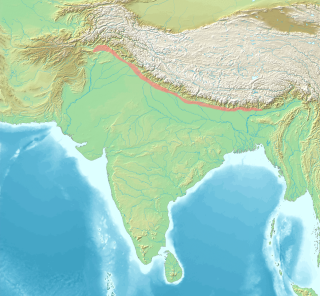
The Sivalik Hills, also known as Churia Hills, are a mountain range of the outer Himalayas. The literal translation of "Sivalik" is 'tresses of Shiva'. The hills are known for their numerous fossils, and is also home to the Soanian Middle Paleolithic archaeological culture.

Amphicyon is an extinct genus of large carnivorans belonging to the family Amphicyonidae, subfamily Amphicyoninae, from the Miocene epoch. Members of this family received their vernacular name for possessing bear-like and dog-like features. They ranged over North America, Europe, Asia, and Africa.

Barbourofelidae is an extinct family of carnivorans of the suborder Feliformia, sometimes known as false saber-toothed cats, that lived in North America, Eurasia and Africa during the Miocene epoch and existed for about 7.9 million years. Thought to be an independent lineage from the Nimravidae and Machairodontinae, which had all attained elongated canines, recent research argues that it may be a subfamily of the Nimravidae, extending its biochronological range into the Miocene, although this issue is not yet fully resolved.
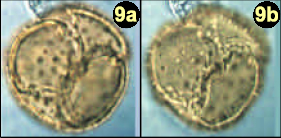
Droseridites is a genus of extinct plants of possible droseracean or nepenthacean affinity. It is a form taxon known only from fossil pollen. Species assigned to this genus originate from numerous regions of the world, including Europe, India, Egypt, the Arabian Peninsula, and the Kerguelen Islands.

Giraffokeryx is an extinct genus of medium-sized giraffids known from the Miocene of the Indian subcontinent and Eurasia. It is distinguished from other giraffids by the four ossicones on its head; one pair in front of the eyes on the anterior aspect of the frontal bone and the other behind the eyes in the frontoparietal region overhanging the temporal fossae. It has a brachydont dentition like in other giraffids and its legs and feet are of medium length. Giraffokeryx is considered monotypic by most authors, in the form of G. punjabiensis, but other species have been assigned to the genus:
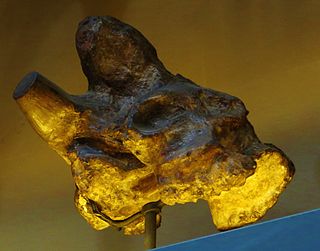
Bramatherium is an extinct genus of giraffids that ranged from India to Turkey in Asia. It is closely related to the larger Sivatherium.
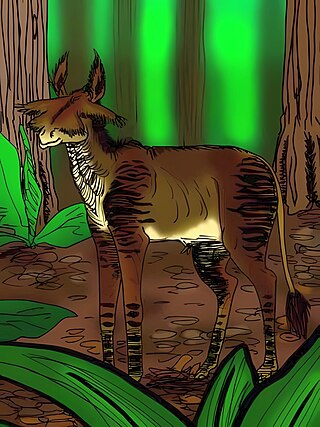
Injanatherium is an extinct genus of giraffids from the Miocene of Iraq, Saudi Arabia, and Pakistan. Species of Injanatherium had at least two pairs of long, wing-like ossicones that emanated laterally above the orbits.
Progiraffa is an extinct genus of giraffid artiodactyls from the Early Miocene of Pakistan. It was first named by Pilgrim in 1908. It resembled more like a horse instead of an giraffe. It may have fed on vegetation found in its open-field habitat.
Indraloris is a fossil primate from the Miocene of India and Pakistan in the family Sivaladapidae. Two species are now recognized: I. himalayensis from Haritalyangar, India and I. kamlialensis from the Pothohar Plateau, Pakistan. Other material from the Potwar Plateau may represent an additional, unnamed species. Body mass estimates range from about 2 kg (4.4 lb) for the smaller I. kamlialensis to over 4 kg (8.8 lb) for the larger I. himalayensis.

Ampullinopsis is an extinct taxonomic genus of deep-water sea snails, marine gastropod molluscs in the clade Sorbeoconcha. These sea snails were epifaunal grazers. Sea snails of this genus lived from Paleocene epoch to Miocene epoch.
Sivaladapis is a genus of adapiform primate that lived in Asia during the middle Miocene.
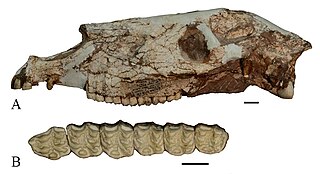
Sivalhippus is an extinct genus of horse that lived in Africa and the Indian subcontinent during the late Miocene.

Enhydriodon is an extinct genus of mustelids known from Africa, Pakistan, and India that lived from the late Miocene to the early Pleistocene. It contains nine confirmed species, two debated species, and at least a few other undescribed species from Africa. The genus belongs to the tribe Enhydriodontini in the otter subfamily Lutrinae. Enhydriodon means "otter tooth" in Ancient Greek and is a reference to its dentition rather than to the Enhydra genus, which includes the modern sea otter and its two prehistoric relatives.
Tetraconodon was an extinct genus of even-toed ungulates that existed during the middle and late Miocene in Asia.
Sivapardus is an extinct, little-known genus of feline with only one species assigned to it, Sivapardus punjabiensis. It was described in 1969 by the paleontologist Abu Bakr based on a partial mandible from the Upper Siwaliks in Pakistan; the locality it was found at is estimated to be from the Late Pliocene to Early Pleistocene. S. punjabiensis was a large cat with a short and broad snout that may have lived on open grasslands.
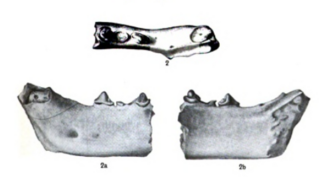
Sivasmilus is a fossil genus of barbourofelid containing only a single species, Sivasmilus copei. It is known from only a single specimen, a partial mandible collected from the Chinji Formation in the Lower Siwaliks in Pakistan, estimated to be from the Miocene. The fossil was originally described in 1915 when it was assigned to the fossil feline Sivaelurus chinjiensis, but was used as the basis of a new genus and species in 1929 by Hungarian paleontologist Miklós Kretzoi. Sivasmilus copei was a relatively small, cat-like animal.
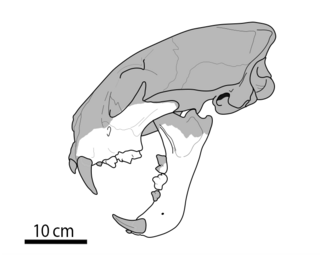
Pachypanthera is an extinct genus of pantherine felid that was recovered from the Late Miocene-aged Khorat sand pits in northeastern Thailand. It contains a single species, Pachypanthera piriyai, named and described in 2023.

Bramiscus is an extinct genus of giraffid artiodactyl ungulates from the Miocene Chinji and Dhok Pathan formations of Pakistan. The genus contains a single species, B. micros, known from several partial skeletons.
Lyra is an extinct genus of giraffid artiodactyl ungulates from the Miocene Chinji Formation of Pakistan. The genus contains a single species, L. sherkana, known from a partial skull and fragmentary ossicones. Lyra may be a member of the subfamily Sivatheriinae. If this classification is correct, it would represent the oldest known sivathere.













